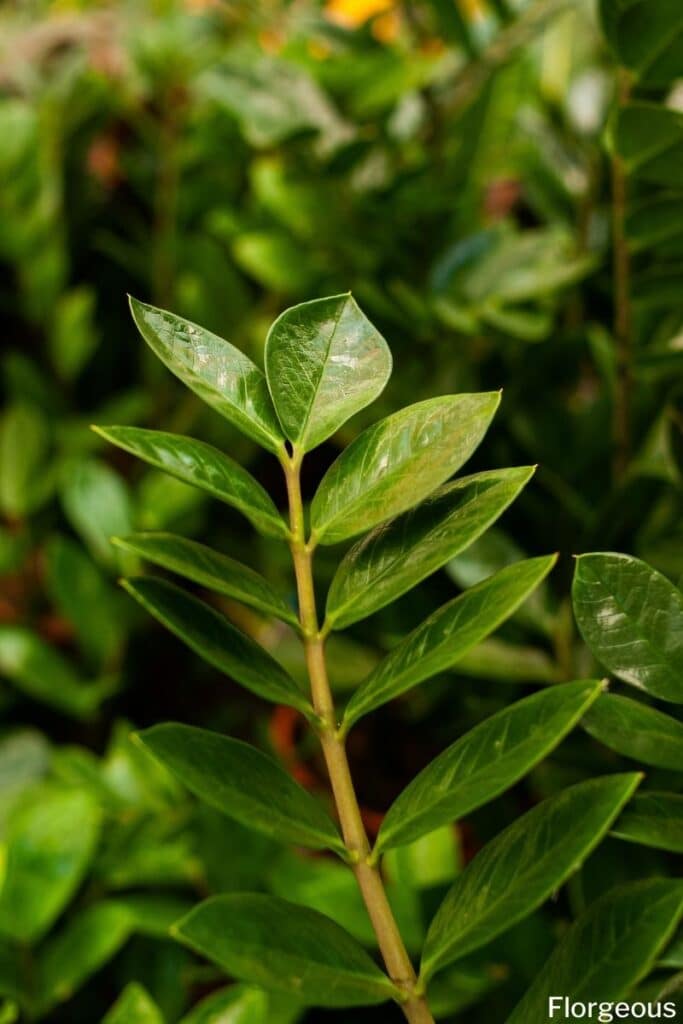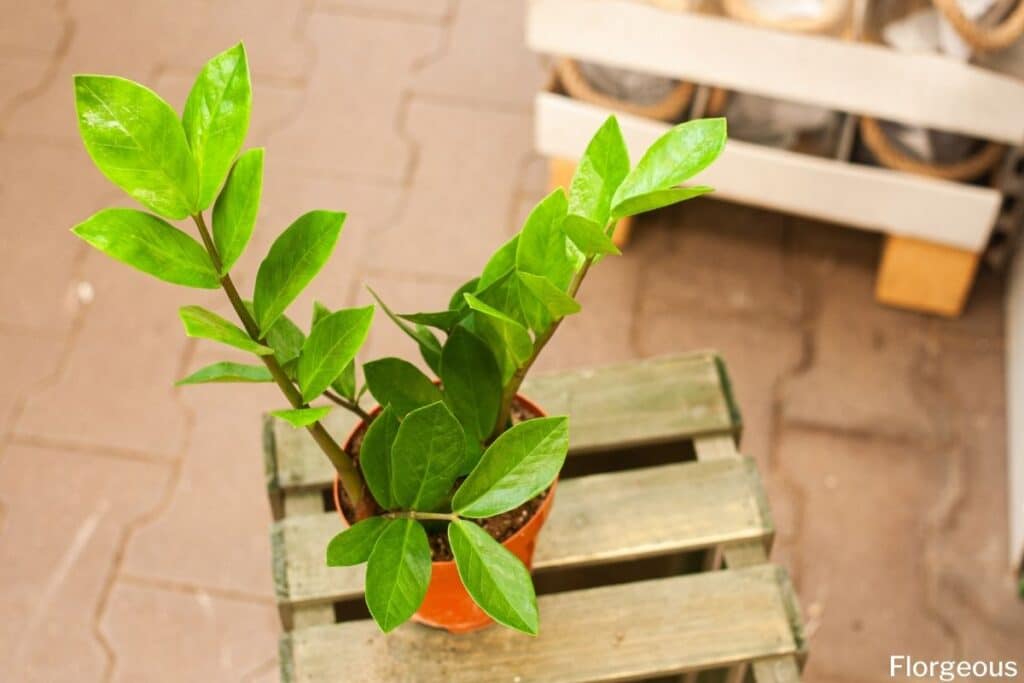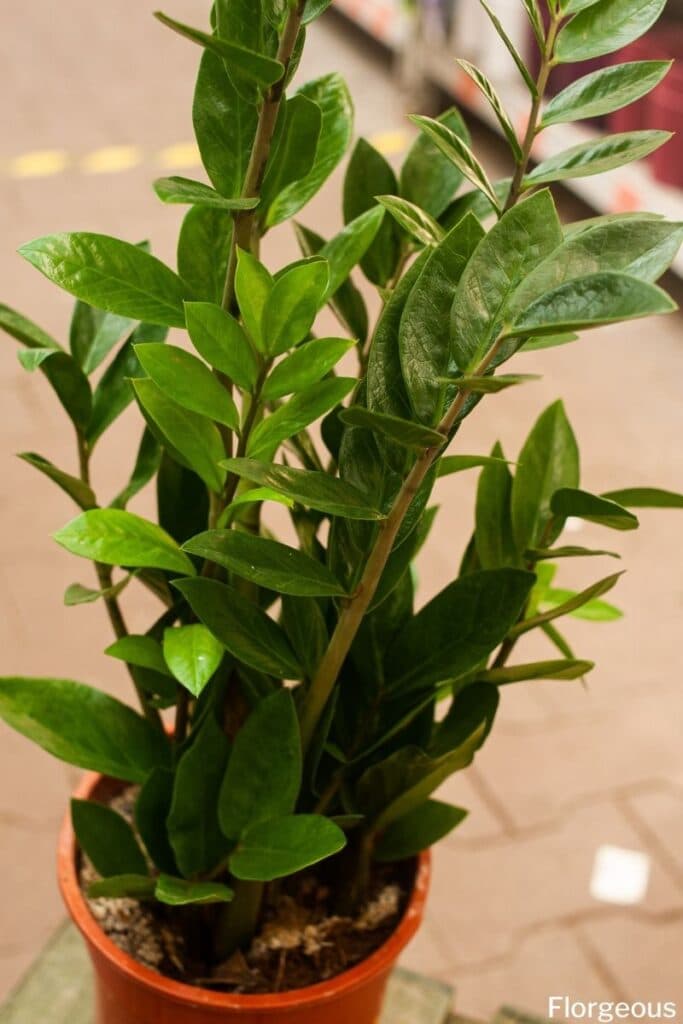Whether you’ve never taken care of a plant before, or just looking for a new houseplant to add to your collection, the ZZ plant should definitely be high on your list. Read this article to learn everything you need to know about growing and caring for this easy houseplant.
ZZ plants (Zanzibar Gem) take their unusual name from the first letters of their scientific name, Zamioculcas zamiifolia. These slow-growing plants are the only species in their genus but are related to other popular houseplants like philodendron and peace lilies. ZZ plants are interesting tropical evergreens that are loved for their glossy foliage and eye-catching, upright form.
Interestingly, the above-ground parts of this medium-sized plant that look like stems and leaves are in fact only large, compound leaves. These leaves grow from a brown underground rhizome, which you could consider to be the plant’s true stem. The leaflets are tough and leathery, and very glossy to the extent that they look almost artificial.
When mature they are deep emerald green, which is where the alternative name of emerald palm comes from. Young foliage usually starts out as a lighter green shade, however. These leaflets measure 1-3 inches (2.5-7.5cm) long and about an inch (2.5cm) across. They grow in 6-8 pairs on fleshy, tapering as rachises. The rachis is the stalk of the plant that looks like a stem.
Plant Facts
| Scientific name | Zamioculcas zamiifolia |
| Common names | ZZ Plant, Zanzibar gem, zuzu plant, eternity plant, aroid palm, or emerald palm |
| Family | Araceae |
| Plant Type | Houseplant |
| Height and Width | 2–4 ft. tall (indoors), 2–4 ft. wide (indoors) |
| Origin | East Africa, Kenya, Tanzania, Mozambique, South Africa, Zimbabwe |
| Flower colors | Cream White |
| Foliage color | Emerald green, variable in cultivation |
| Sun Exposure | Bright indirect light |
| Soil Type & pH | Well-drained, neutral to slightly acid soil |
| Special features | Low Maintenance, Low Light |
How to Grow A Zanzibar Gem Plant
ZZ plants are evergreen plants that are most popularly grown in containers indoors, although they can be grown outdoors in warmer areas. These plants are typically bought as established plants in containers and are very easy to grow if given the right amount of light, water, and nutrients.
Propagate ZZ plants
It’s relatively easy to propagate ZZ plants. While it is possible to grow these plants from seeds, fruits are rarely produced at home, so seeds can be hard to come by. Vegetative propagation is definitely the best option for growing new plants in most cases, and this can be done by division or even leaf cuttings.

Soil
This hardy houseplant doesn’t need any special soil but will do best in a well-drained substrate. The simple soil mixture for zz plants that works well for the species is 1 part sand to 3 parts organic potting soil. A good quality potting soil for cactus with some compost content that will drain well is another great option.
Pruning
ZZ plants rarely need to be pruned at all. Due to the fact that the above-ground parts of this plant consist of large, compound leaves, pruning is not advised. If a leaf is damaged or diseased, however, it should be cut off with a sharp clean implement just above the soil line.
Repotting and Transplanting
It is relatively easy to transplant and repot. These plants have robust root systems and rhizomes that mean they are not overly sensitive to disturbance. If you plan on transplanting or repotting ZZ plants, do it in the spring or fall, and give it a thorough watering the day before.

How to Care for ZZ Plant
As you can tell, caring for the ZZ plant is very easy. They are pretty slow-growing plants, which is definitely a positive quality when choosing a low-maintenance plant. Whenever possible, select a plant that is already a decent size and shape. A specimen with multiple stems is always a good bet because that’s a sign of good rhizome development.
Caring for these house plants doesn’t take much time at all, and is pretty similar to caring for potted succulents. Apart from watering every few weeks, your only real maintenance will involve applying fertilizer and wiping down the leaves from time to time.
If your plant starts to look a little dusty, wipe the leaves with a damp cloth to restore their shine. This also helps to keep the leaf’s cuticle healthy and keep pests at bay.
Water
Once you’ve bought your new ZZ plant or propagated one for yourself, you will find that growing zz plant in the home is very easy indeed! These plants grow from well-developed underground rhizomes and fleshy stalks, which are great adaptations for storing water and nutrients. That’s a clear sign that this plant is very efficient with its use of water.
This means your plant does not need to be watered frequently and will easily survive if you forget to water it. The best advice is to water the plant well, but allow the soil to dry out to a depth of about 2 inches (5cm) before watering again. Watering once every two or three weeks throughout the year is usually about right.
How much water the plant needs does vary to some extent on the temperature and strength of the light it gets, so keep an eye on your plant and feel the soil to get your timing right. Remember, it is better to be underwater than to drown these water-wise evergreens.
Sunlight
Although the Zanzibar Gem plant is famous for its ability to live in low light conditions, it will definitely perform best in bright, but indirect light near an east or west-facing window. This species is native to Eastern Africa, a humid part of the world, but these hardy plants are also very tolerant of low humidity environments and will do just fine in the average household.
Temperature and Humidity
The Zanzibar gem prefers a warm environment but will do well in ambient temperatures of 60-75°F (15-24°C). If you plan to give your plant some outdoor time, avoid shocking it with any extremes of temperature or light. These indoor plants are adaptable to the conditions of USDA zones 10 and 11.

Fertilizer
Being a slow-growing plant, these gems really don’t need much in the way of fertilizer. If you want to improve its growth rate a little and keep it as vigorous as possible, however, supplement with a fertilizer that contains all of the macro and micronutrients that plants need.
This can be applied at half strength, taking note of the instructions supplied with your chosen fertilizer. The plants should be fed during the growing seasons of spring and fall, but allowed to rest in winter and summer.
Pest and diseases
ZZ plants are generally very resistant to attack from insects because of their tough, waxy leaves. They can be susceptible to brown scale, mealy bugs, and red spider mites though, especially if they are grown next to other plants that are more attractive to these pests.
Another issue to watch out for is too much light. Direct sunlight can cause the leaves to curl and burn, which is why these plants should be positioned in bright but indirect light, or grown under grow lights. If your ZZ plant is dropping its leaves, it may be in shock from being moved to a bright spot.
The most common sign of poor health in this species is yellowing leaves, however, and this is usually the result of too much watering. Apart from the yellow leaves, root rot can also be part of the deal if these plants are kept wet. The leaves of plants that are underwatered may turn brown at the tips, but being a drought-tolerant plant, it will readily recover with a nice watering.
Common Zamioculcas Zamiifolia Varieties and Cultivars
There are at least a dozen different forms and cultivars of the ZZ plant available. These different options vary in both size and leaflet arrangement, as well as color. Variegated options are available as well as very interesting forms with white, yellow, and even black leaves.
Some well-known cultivars of ZZ plant and varieties include:
- ZZ Raven
- ZZ ‘Zamicro’
- ZZ ‘Zenzi’
FAQs
How do I make my ZZ plant bushy?
To encourage bushiness in your ZZ plant, prune it selectively by cutting back stems to just above a leaf node. This will prompt new growth from the nodes and create a fuller appearance.
Should I mist my ZZ plant?
While ZZ plants are generally tolerant of dry conditions, occasional misting can be beneficial, especially in dry indoor environments or during winter when indoor heating dries out the air. However, avoid over-misting as ZZ plants are susceptible to root rot.
Does the ZZ plant like big pots?
ZZ plants prefer slightly tight quarters, so it’s best to choose a pot that’s just slightly larger than the root ball. Too large of a pot can lead to overwatering and potentially root rot. A pot that’s about 1-2 inches larger in diameter than the current root ball is usually sufficient.
Conclusion
The ZZ plant is practically bullet-proof and an excellent house plant for beginners or growers who don’t want to spend much time on plant maintenance. With their glossy leaves and slow growth rate, these easy evergreens could even be mistaken for artificial plants! Unfortunately, this plant does have some toxic properties, but as long as you are responsible about where you position it, this doesn’t have to be a deal-breaker.
See more:






